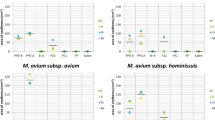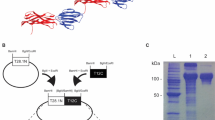Abstract
THE interconnexion between the protective antigen and the histamine-sensitizing factor of B. pertussis forms the subject of earlier reports1–11. Results agree in that the two factors, if not identical, are in any event closely related as regards both their site in the bacterial cell11 and their activity. We have studied the behaviour of the protective antigen and the histamine-sensitizing factor under conditions which may impair pertussis vaccines in the course of preparation. We produced 3-day-old cultures of each of six B. pertussis strains of phase I on solid semi-synthetic medium. After centrifuging them, the sediment was resuspended in buffered saline so as to obtain suspensions containing 500 × 109 cells/ml. The suspensions were divided in two parts : the first was treated with 0.3 per cent formalin and kept at 37 °C. for 24 hr., the second with merthiolate (1 : 5,000) and heated to 56° C. for 30 min. Both kinds of suspensions were then stored at + 4° C. We prepared, moreover, suspensions from a mixture which contained all the six strains in equal proportions. These too were divided into formalin and merthiolate fractions (7 formalin, 7 merthiolate ; 8 formalin., 8 merthiolate). Seven and 8 merthiolate seemed to be especially satisfactory in respect of protective potency and histamine-sensitizing activity: we prepared two precipitated vaccines from each of them. One contained 7 mgm./ml. of preformed aluminium phosphate gel (Holt12) ; a solution of trisodium phosphate was first added to the suspension in the case of the other vaccine and followed immediately by the admixture of a solution of aluminium chloride producing aluminium phosphate gel in statu nascendi. This vaccine contained likewise 7 mgm. of aluminium phosphate/ml. The addition of trisodium phosphate was observed to have raised the pH value of the mixture to 14. We determined the mouse-protect ion value of the suspensions and precipitated vaccines according to the prescriptions of the National Institutes of Health, Bethesda13, and their histamine-sensitizing activity by the method of Preston14. It is evident from Table 1 that suspensions treated with merthiolate were significantly superior to those treated with formalin as regards both mouse-protective potency and histamine-sensitizing activity. The respective values of the two factors thus ran along parallel courses, and this close correlation was independent of whether old or fresh vaccines were employed. As regards precipitated vaccines, it is shown by our results that, however short their duration, strong alkalinity considerably impairs mouse-protective potency and histamine-sensitizing activity, while they are not affected by the preformed gel of Holt. Repeated tests confirmed these results in every respect.
This is a preview of subscription content, access via your institution
Access options
Subscribe to this journal
Receive 51 print issues and online access
$199.00 per year
only $3.90 per issue
Buy this article
- Purchase on Springer Link
- Instant access to full article PDF
Prices may be subject to local taxes which are calculated during checkout
Similar content being viewed by others
References
Halpern, B. N., and Roux, J., C. R. Soc. Biol., 143, 923 (1949).
Pittman, M., J. Infect. Dis., 89, 300 (1951).
Kind, L. S., J. Immunol., 70, 411 (1953).
Pillemer, L., Blum, L., and Lepow, I. H., Lancet, i, 1257 (1954).
Maitland, H. B., Kohn, R., and MacDonald, A. D., J. Hyg. (Camb.), 53, 196 (1955).
Fishel, Ch. W., J. Infect. Dis., 99, 44 (1956).
Maitland, H. B., and Guérault, A., J. Path. Bact., 76, 257 (1958).
Dolby, J. M., Immunology, 1, 328 (1958).
Kuwajima, Y., Matsui, T., Naka, K., and Kanai, Y., J. Hyg. Epidemiol. Microbiol. and Immunol., 2, 274 (1958).
Kind, L. S., Bact. Rev., 12, 173 (1958).
Munoz, J., Ribi, E., and Larson, C. L., J. Immunol., 83, 496 (1959).
Holt, L. B., “Developments in Diphtheria Prophylaxis” (London, 1950).
National Institutes of Health, “Minimum Requirements for Pertussis Vaccine” (Bethesda, Md., first revision, Oct. 31, 1952).
Preston, N. W., J. Path. Bact., 78, 217 (1959).
Author information
Authors and Affiliations
Rights and permissions
About this article
Cite this article
JOÓ, I., PUSZTAI, Z. Interconnexion between the Protective Antigen and the Histamine-sensitizing Factor of Bordetella pertussis . Nature 188, 331–332 (1960). https://doi.org/10.1038/188331b0
Issue Date:
DOI: https://doi.org/10.1038/188331b0
Comments
By submitting a comment you agree to abide by our Terms and Community Guidelines. If you find something abusive or that does not comply with our terms or guidelines please flag it as inappropriate.



